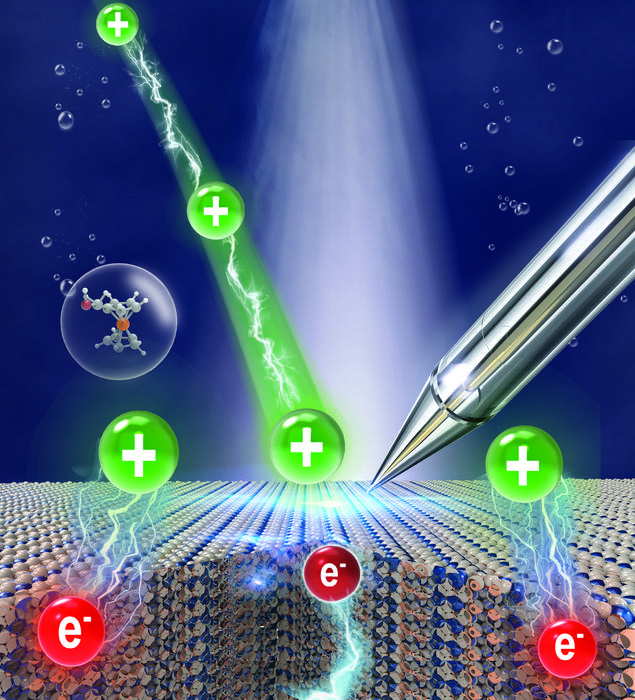
Researchers have made significant strides in the field of photocatalysis, a process integral to a variety of applications spanning energy conversion, chemical synthesis, and environmental remediation. Central to this phenomenon are the complex interactions of light absorption, charge separation, and chemical reactions occurring at the interface between solids and liquids. The challenge has been to decipher the underlying mechanisms that dictate these processes, particularly the charge transfer dynamics. A promising new study sheds light on this intricacy, employing an innovative methodology to reveal essential insights.
Photocatalysis fundamentally relies upon the conversion of solar energy into chemical energy through a series of well-orchestrated steps. At the core of these processes lies the interplay of surface charges and charge transfer mechanisms, a relationship that has increasingly become a focus of research efforts. The site where these interactions occur is the solid-liquid interface, a region where electrostatic forces can profoundly influence reaction kinetics and efficiency. Traditionally, much of the research landscape has concentrated on solid catalysts, overlooking the potential and critical role that the liquid electrolyte plays in such systems.
A study recently published in the esteemed Journal of the American Chemical Society takes a groundbreaking approach to investigating these interactions. Professors FAN Fengtao and LI Can, alongside their team from the Dalian Institute of Chemical Physics, have devised an innovative technique to probe surface charges within liquid environments. Their methodology effectively isolates electrostatic forces from the longer-range interactions, allowing them to map the electric field distribution within the electrical double layer more accurately than ever before.
One of the key breakthroughs of this work is the ability to directly measure surface potential and photovoltage under realistic liquid conditions. This capability enables researchers to quantify how factors such as pH affect the local surface potential in the electrolyte. The findings indicate that surface charges at the solid-liquid interface generate an additional driving force, which exponentially enhances the movement of photogenerated electrons to the surface, thereby facilitating the desired charge transfer reactions. This discovery is pivotal; it provides a crucial mechanism that can be manipulated to improve photocatalytic processes.
The researchers offer compelling quantitative demonstrations that elucidate the relationship between surface potential and the flux of reaction products. This relationship is vital in understanding how the rate of photocatalytic reactions, particularly the oxygen evolution reaction, is controlled by the electric field generated by surface charges. Through this work, the research team also identified an optimal pH range that promotes effective spatial separation of the photogenerated electrons and holes, a necessary condition for enhancing reaction efficiency.
Furthermore, researchers successfully visualized the entire charge transfer process, mapping it from the space charge region to the active reaction sites. This sophisticated imaging framework presents a novel way of examining charge transfer kinetics at a nanoscale, offering researchers a powerful tool to design more efficient photocatalysts while simultaneously optimizing reaction conditions for various applications.
The implications of these findings are significant for the field of photocatalysis, providing new pathways to tackle longstanding bottlenecks in photocatalytic reactions. Both FAN and LI emphasize the transformative potential of this research, suggesting that their insights could drive future advancements in photocatalytic technologies, particularly in the domains of clean energy production and environmental applications.
As the field continues to evolve, understanding the dynamics at play within the electrical double layer becomes increasingly crucial. The innovative approach developed by this research team not only clarifies existing hypotheses but also sets the stage for further exploration in this vital area of study. Given the global emphasis on sustainable technologies, solutions derived from these insights could have far-reaching impacts on energy and resource management.
Looking ahead, it is clear that addressing the challenges associated with photocatalysis will require continued innovation and interdisciplinary collaboration. The work presented by FAN, LI, and their team exemplifies the type of research that can catalyze change, bridging gaps in our understanding of charge transfer and its environmental applications. As we continue to explore the potential of photocatalysis in various sectors, integrating the insights from this study will be essential in devising efficient strategies for harnessing solar energy.
In conclusion, this research marks a significant milestone in the quest to understand the intricate dance of forces at play in photocatalytic processes. The implications are wide-ranging and could see advancements in technologies related to energy conversion, pollution control, and beyond. The community awaits with eager anticipation for future discoveries stemming from this pivotal work, potentially reshaping our approach to photocatalysis and its practical applications in addressing world challenges.
Subject of Research: Photogenerated Charge Transfer Mechanisms in Photocatalysis
Article Title: Impact of Reaction Environment on Photogenerated Charge Transfer Demonstrated by Sequential Imaging
News Publication Date: 5-Mar-2025
Web References: DOI
References: Journal of the American Chemical Society
Image Credits: Credit: DICP
Keywords
Photocatalysis, Charge transfer, Electron reactions, Imaging
Tags: charge transfer dynamics in electrolyteschemical synthesis processeselectrostatic forces in chemical reactionsenergy conversion technologiesenvironmental remediation strategiesinnovative methodologies in photocatalysisJournal of the American Chemical Society publicationsliquid electrolyte roles in catalysisphotocatalysis researchreaction kinetics and efficiencysolar energy conversionsolid-liquid interface interactions





